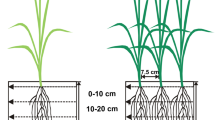Abstract
A method to control the rhizosphere pH of plants under controlled nutritional conditions is suggested. An earlier developed method for plant growth in soilless culture according to the principle of regeneration and pH control by adjusting the percentage of total N supplied as NH4-N in the maintenance solution was applied to control rhizosphere pH in connection with a recently developed plant-growing technique. Using this technique, thin soil layers (0.2 mm) at different proximity to a root mat can be sliced from a soil column and analyzed.
Results show a high predictive values with respect to pH profiles in the soil and demonstrate that nutrition of the rape plants was kept equal when rhizosphere pH decreased by 1.2 units, and was kept constant or was increased by 0.4 units by varying the percentage of total N supplied as NH4-N (15, 6 or 0) in the nutrient solutions via wicks and not via the soil column. The method thus offers new possibilities in rhizosphere studies, as control of pH in the rhizosphere of plants under equal nutritional conditions has been a problem for a long time.
Similar content being viewed by others
References
Bagshaw, R, Vaidyanathan, L V and Nye, P H 1972 The supply of nutrient ions by diffusion in plant roots in soil. VI. Effect of onion plant roots on pH and phosphate desorption characteristics in a sandy soil. Plant and Soil 37, 627–639.
Bergmann, W 1988 Ernährungsstörungen bei Kulturpflanzen. Gustav Fischer Verlag, Stuttgart, New York. 762 p.
Breteler, H 1973 A comparison between ammonium and nitrate nutrition of young sugar-beet plants grown in nutrient solutions at constant acidity. I. Production of dry matter, ionic balance and chemical composition. Neth. J. Agric. Sci. 21, 227–244.
Gahoonia, T S and Nielsen, N E 1991 A method to study rhizosphere processes in thin soil layers of different proximity to roots. Plant and Soil 135, 143–146.
Grinsted, M J, Hedley, M J, White, R E and Nye, P H 1982 Plant-induced changes in the rhizosphere of rape (Brassica napus var. Emerald) seedlings. I. pH changes and the increase in P concentration in the soil solution. New Phytol. 91, 19–29.
Hedley, M J, Nye, P H and White, R E 1982 Plant-induced changes in the rhizosphere of rape (Brassica napus var. Emerald) seedlings. II. Origin of the pH change. New Phytol. 91, 31–44.
Marschner, H and Romheld, V 1983 In vivo measurements of root-induced pH changes at the soil-root interface. Z. Pflanzenphysiol. 111, 241–251.
Nielsen, N E 1984 Crop production in recirculating nutrient solution according to the principle of regeneration. Proc. 6th Int. Congr. of Soilless Culture. Int. Soc. of Soilless Culture, Lunteren, The Netherlands, pp 421–446.
Nye, P H 1981 pH changes across the rhizosphere induced by roots Plant and Soil 61, 7–26.
Riley, D and Barber, S A 1971 Effect of ammonium and nitrate fertilization on phosphorus uptake as related to root-induced pH changes at the root-soil interface. Soil Sci. Soc. Am. Proc. 35, 301–306.
Author information
Authors and Affiliations
Rights and permissions
About this article
Cite this article
Gahoonia, T.S., Nielsen, N.E. Control of pH at the soil-root interface. Plant Soil 140, 49–54 (1992). https://doi.org/10.1007/BF00012806
Received:
Issue Date:
DOI: https://doi.org/10.1007/BF00012806




